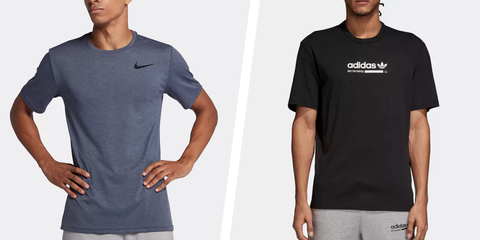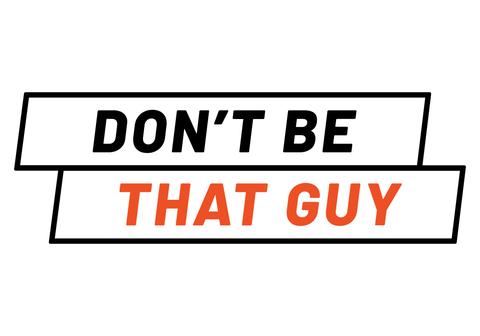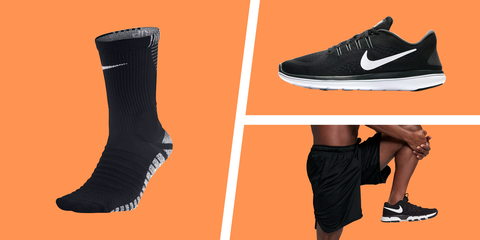


Eric Rosati/Men's Health
Welcome to Don’t Be That Guy, where we answer all of your most pressing, weirdly specific questions about what type of behavior is — and isn’t — OK at the gym.
A few weeks ago, my brother called with a question that he clearly believed to be of the utmost urgency. “What’s the protocol for mixing and matching activewear?” he asked. “Is it OK to wear multiple fitness brands at once?”
Almost immediately, I responded with a horrified, “No!” But truth be told, it was a pretty visceral reaction. I couldn’t quite explain it, but something about pairing a swoosh-emblazoned Nike shirt with Adidas’ signature striped sweats seemed…well…wrong.
On the other hand, I’ve always felt that rocking the same brand from head to toe has always felt like the epitome of cool. When I’m wearing, say, Adidas from head-to-toe, I feel totally put-together, which makes me feel like I can conquer any obstacle and do absolutely anything — and when I’m hyping myself up to log some miles or hit the weights, I need every ounce of confidence that you can get.
I’m not the only person who feels this way. When I informally polled my friends, many of them said that not only did they vastly prefer repping an individual brand at the gym, but they felt weird mixing and matching brands. Like me, their reasoning wasn’t really rooted in solid logic. Some explained that they were “just following the rules” — though they weren’t quite sure who came up with those rules in the first place.
So is it actually a faux pas to mix and match Under Armor compression leggings with a Reebok shirt? Or is that just the uber-effective fitness apparel marketing machine at work? And, perhaps most importantly: where does the idea that we had to be “loyal” to one brand come from in the first place?
We know for a fact that what we wear to the gym plays a role in how we feel about working out. According to a recent survey of 2,000 gym-goers, 58% said that putting on workout gear is the ultimate source of motivation, and 85% reported that having “cool-looking” gym clothes gave them more confidence to get off the couch.
Although the research is mixed on whether or not what you wear to the gym can actually boost your performance, that confidence boost is invaluable. And for many people who are serious about fitness, this can translate into the feeling that our confidence is highest when we’re decked out in our favorite brand head-to-toe.
“There’s a tendency for brand loyalty, but it’s not universal,” says Daniel Freedman, co-CEO of fitness startup BurnAlong. “It depends on the engagement of the gym-goer. People put on personas when they work out, and their uniform parallels that.” On some level, we clearly believe that if we can look like Nike Master Trainers head-to-toe, maybe we can perform like one, too — and this manifests itself in what’s known in the marketing world as “brand loyalty.”

Nike
Extreme brand loyalty is usually the result of two factors. The first and most obvious factor is the customer’s satisfaction with the company’s products. The second, more amorphous factor is that the customer identifies with the company’s values and image.
That’s especially the case if that brand-consumer relationship started at a young age and was continually reinforced over time, says Vassilis Dalakas, professor of marketing at California State University San Marcos.
“People who were kids or teens when Nike introduced Michael Jordan and ‘Just Do It’ are more likely to embrace Nike as a brand that you use to push yourself and to overcome challenges,” says Dalakas. “As a result, they stay loyal to it, [despite having] other options.”
“I love my Americanos, but they don’t make me feel like Serena Williams. Wearing whatever Serena Williams is wearing makes me feel like Serena Williams.”
Mike Turner, the founder of the Atlanta-based gym Unity Fitness, can attest to this firsthand. “Growing up as an avid football and basketball player, everything had to be Nike,” he told me. “That was the case for all of my friends who played the same sports. At the time, all we saw on TV was Nike, because nearly all of the prestigious football and basketball teams had Nike sponsorships.” Decades of being subjected to brands’ multimillion dollar marketing campaigns has led us all to become brand snobs, whether we realize it or not.
That’s especially true for fitness brands, who rely on celebrities like Jordan to help sell products, explains Matt Johnson, associate dean and professor of psychology at Hult International Business School in San Francisco. “Athletic and fitness wear companies are unique in the degree to which they utilize and rely on athlete endorsements,” he said. “These celebrities and icons effectively personify the brand and galvanize their following.”
If a brand has made all the right marketing choices and sponsorship deals, the payoff can be immense, both literally (the global market for sports and fitness clothing is projected to reach $231.7 billion by 2024, according to Global Industry Analysts, Inc.) and figuratively.
That’s why brands like Nike and Adidas foster a different kind of brand loyalty than one might have for, say, Target or Starbucks. I love my Americanos, but they don’t make me feel like Serena Williams. Wearing whatever Serena Williams is wearing, however, makes me feel like Serena Williams.
It might sound weird to use words like “relationship” or “loyalty” in relation to something like a multibillion-dollar corporation. But it actually makes perfect sense, says Dalakas: “Why we become loyal to a brand is quite similar to why we become loyal to a person,” Dalakas says. “It comes down mostly to trust.”
Take, for example, Patagonia, the outdoor clothing and gear brand well-known for its progressive politics and environmental activism. The California-based outfitter has about 3.5 million followers on Instagram, in large part, Dalakas speculates, because “wearing that brand communicates to others that you agree with and support these practices because you have similar values.”
In other words, rocking a Patagonia fleece with your Patagonia board shorts isn’t just an expression of how much you like the product. It’s an expression of how you see yourself — or, perhaps more accurately, how you want the rest of the world to see you.
The frequently open High Sierra weather window. Photo: Tad McCrea
A post shared by Patagonia (@patagonia) on
Of course, none of this necessarily means that rocking one brand consistently looks particularly good. Wearing head-to-toe swooshes or stripes is probably overkill, says Chad Moeller, a Wisconsin-based personal trainer.
“If you are branded from head to toe, you could come across a little too strong,” Moeller told me. “You will lose some of your personal identity. A brand should complement your personal identity, not overpower it.”
So the next time you’re contemplating your #GymFit, just remember that it all comes down this: While it may feel strange for the Type As of the world (and/or anyone who’s been subject to decades of targeted branding), it’s totally fine to mix swooshes and stripes and whatever other logo you desire.
But at the same time, if you find it tough to stray from a certain brand of running shoes, or a specific type of moisture-wicking fabric, that makes sense too. Because brands like Nike, Adidas, and Patagonia haven’t just built a customer base — they’ve built a tribe. And if you’ve found your tribe, why would you ever leave it?
Source: Read Full Article